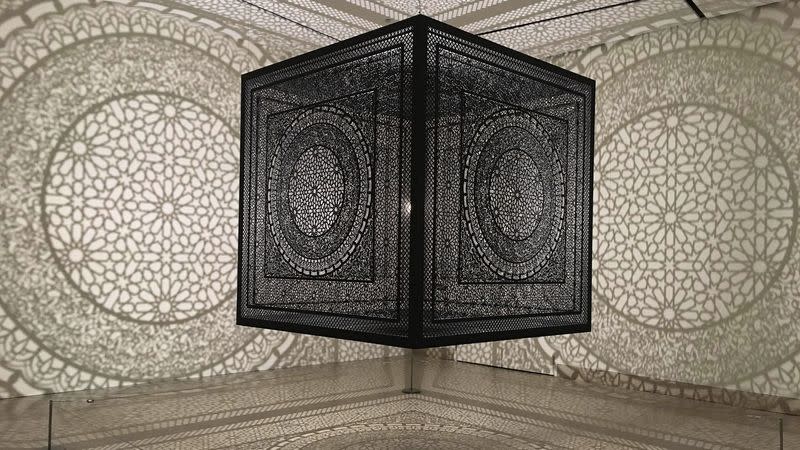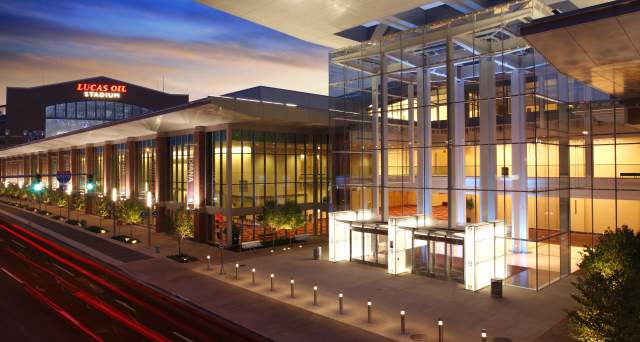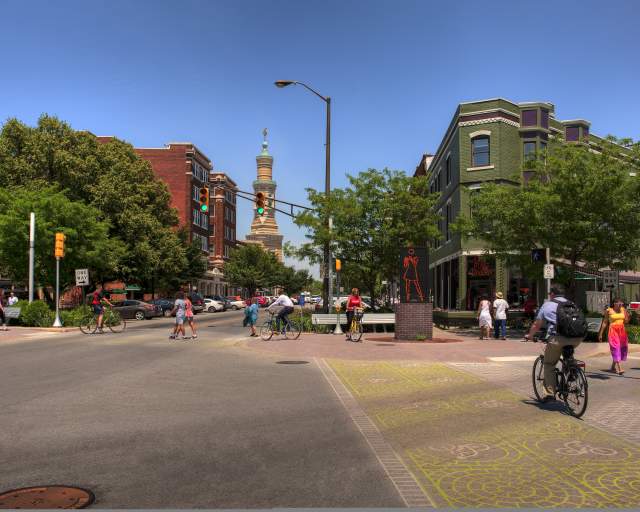A new exhibition at the Indiana State Museum highlights two centuries of Hoosier artwork. The exhibition, 200 Years of Indiana Art: A Cultural Legacy, runs through Oct. 2 and marks the state’s bicentennial celebration. It includes more than 100 two- and three-dimensional works of art and showcases the depth, diversity, and breadth of artistic talent associated with Indiana.
There are paintings, sketches, and textiles. There are works by early pioneer painters, and visual artworks made from broken records or discarded CDs. And then there’s Intersections, Anila Agha’s 2014 ArtPrize-winning installation.
 “Among our many offerings, we are thrilled to host … Intersections,” said Mark Ruschman, chief curator of fine art. “It will be the first time the piece has been shown in Indiana since winning the international art competition’s top honor.”
“Among our many offerings, we are thrilled to host … Intersections,” said Mark Ruschman, chief curator of fine art. “It will be the first time the piece has been shown in Indiana since winning the international art competition’s top honor.”
Just weeks before the competition, the Harrison Center for the Arts presented a prototype of Intersections, whose geometric shapes and lines were inspired by the Alhambra in Granada, Spain. The intricate, black box appears to levitate. And a single bulb—suspended from ceiling—casts 360-degree shadows from inside the box. It’s beautiful. It’s mesmerizing. And it’s completely free to view.
So, if you’re on the Cultural Trail and would like to stop in, do it. Intersections is located on the first floor, in a custom gallery the museum constructed to accommodate the piece. And while you’re at it, you can view additional public installations, including a site-specific, two-story piece created by graffiti artists, and an artwork by Leticia R. Bajuyo that transforms the entrance to the museum from the garage.
The majority of 200 Years is located on the third floor of the museum, however, and is included in the price of admission. It comprises both the NiSource and Ford galleries, with the first 100 years of Indiana art installed in NiSource, and the second 100 years in Ford.
 Presented in chronological order, the NiSource display includes paintings by 19th-century painters George Winter, Jacob Cox, and Marcus Mote. The exhibition then transitions to works from the Hoosier Group, a group of Indiana impressionist painters led by T.C. Steele. Steele later moved to Brown County and, alongside Adolph and Ada Shulz, helped found the Brown County Art Colony. During that time, artists were drawn to pastoral scenes and the natural beauty of the southern countryside.
Presented in chronological order, the NiSource display includes paintings by 19th-century painters George Winter, Jacob Cox, and Marcus Mote. The exhibition then transitions to works from the Hoosier Group, a group of Indiana impressionist painters led by T.C. Steele. Steele later moved to Brown County and, alongside Adolph and Ada Shulz, helped found the Brown County Art Colony. During that time, artists were drawn to pastoral scenes and the natural beauty of the southern countryside.
By the 1920s, the state was evolving from a rural and agricultural society to one that was urban and industrial. Artists shifted their interest toward imagery familiar to everyday life: the hustle and bustle on the streets; gritty, industrial scenes that reflected a changing Indiana. The Ford Gallery guides visitors through this period of influence and to the present day, showcasing artworks by Robert Indiana, Alma Eikerman, David Smith, and Kay Rosen.
200 Years highlights more than just the familiar names, however. It also reflects the state’s changing population and ethnic diversity.
“…This important exhibition [showcases] the tremendous artistic talent associated with the state,” said Ruschman. “We’ve assembled a collection of works that illustrate the evolution and influence of the visual arts throughout our 200-year history.”
200 Years is a signature project of the Indiana Bicentennial Commission, with support from the Indiana Arts Commission. The National Endowment for the Arts, Arts Council of Indianapolis, and City of Indianapolis provided additional funding and support.
The exhibition runs through Oct. 2 and is included with museum admission.



